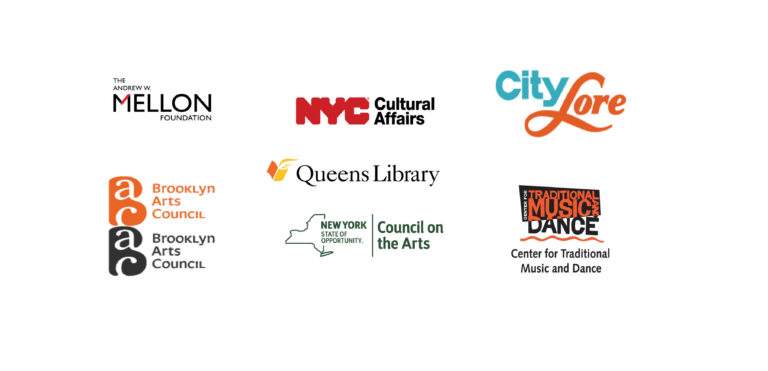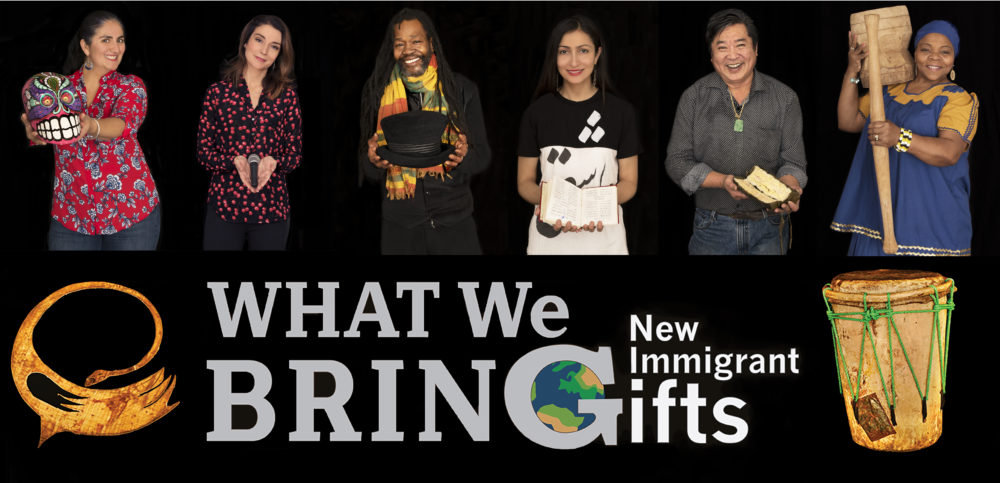City Lore Presents:
What We Bring: New Immigrant Gifts
Spotlighting the Contributions of Artists from New York City’s Immigrant Communities
About
What We Bring: New Immigrant Gifts adds to the national dialogue on immigration, bringing in to focus the cultural contributions of new immigrants. With this exhibition, we mark the fiftieth anniversary of the Hart-Celler Immigration and Nationality Act, implemented in 1968, which inaugurated a new era of immigration from Asia, Latin America, Africa and the Caribbean. What We Bring celebrates the rich layers of creativity, tradition, and increased cultural diversity that the law set in motion, especially in New York City, where 6-in-10 residents are first generation or the children of immigrants.
The thirty-one artists, some widely known, some known primarily in their own communities, span twenty-five countries with artistic disciplines that range from music to cooking, poetry to dance, visual arts to theater. They have brought special skills, knowledge and/or perspectives that inform their contributions to the American patchwork. Their arts are gifts with no strings attached. We invite you to consider their stories, and think about your own and your family’s gifts to the country you call home.
Immigration and Nationalities Act of 1965
Our beautiful America was built by a nation of strangers. From a hundred different places or more they poured forth…The land flourished because it was fed from so many sources– because it was nourished by so many cultures and traditions and peoples.
~Lyndon Johnson on signing the Hart-Celler Act on October 3, 1965
When new immigrants from many world cultures create a vital cultural life in this country, this becomes their home. America is home to the world’s peoples. When new immigrants arrive in this country, they are coming home.
~Chike Nwoffia, entrepreneur and Nigerian immigrant
Here’s to the manicurist who had to leave her family to come here, painting the nails, scrubbing the feet of strangers. Here’s to the janitors who don’t understand English yet work hard despite it all. Here’s to the fast food workers who work hard to see their family smile. Here’s to the laundry man at the Marriott who told me with the sparkle in his eyes how he was an engineer in Peru. Here’s to the bus driver, the Turkish Sufi who almost danced when I quoted Rumi… Here’s to the taxi drivers from Nigeria, Ghana, Egypt and India who gossip amongst themselves… Here is to their children, to the children who despite it all become artists, writers, teachers, doctors, lawyers, activists and rebels.
~ Ijeoma Umebinyuo, Questions for Ada, 2015
Movement of the body and mind is vital for human survival and prosperity. We are essentially water. Water must flow. Water that does not move stagnates. Migration is to humans as flow is to water.
~Kewulay Kamara, finah poet and Sierra Leonean immigrant
Our Featured Immigrant Artists
**ALL PORTRAIT PHOTOS TAKEN BY TOM PITCH**
Click on the artist’s image or name to get their full story!
n’Ketiah Brakohiapa; Ghana: clothing designer, teacher
Object: Sankofa fabric print resist
Seh owere fi na wo san ko fa aa yen kyiri.
(Twi)
[Forgetfulness is not an abomination if you return to reclaim the good teachings you learned in life.]

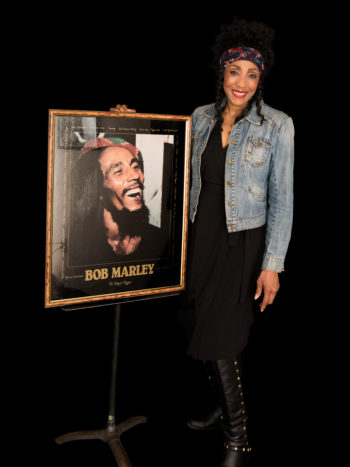
Cindy Campbell; Jamaica: the “Muse of Hip Hop”
Object: a poster of Bob Marley
It’s like someone waved a wand over the neighborhood.
Carolina Calvache; Colombia: musician
Object: song lyric and poem
Hay días en que somos tan móviles, tan móviles Como las leves briznas al viento y al azar
Tal vez bajo otro cielo la gloria nos sonría
La vida es clara, undívaga y abierta como un mar. -Porfi rio Barba Jacob, “Canción de la vida profunda” (Spanish)
[There are days when we’re so variable, so variable, / As the light blade of grass to the wind and chance. / Maybe glory smiles at us under other skies, / For life is clear, billowy, and open like the ocean.]
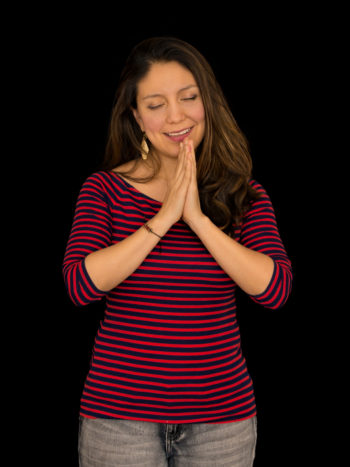
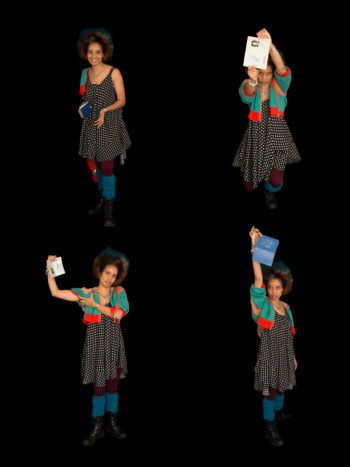
Staceyann Chin; Jamaica: slam poet, theater artist
Object: expired Jamaican passport
I came to America to find some kind of freedom
Sidiki Conde; Guinea: dancer, choreographer, musician, founder of Tokounou Dance Company
Object: krin log drum
Kana miri fela morya ma ka dantambi, i ke wali yiraka morlu la, ini sewa ila dunuya teroh.
[“Don’t think too much about your disability. Think about what you can do for society and be grateful for this life.”]
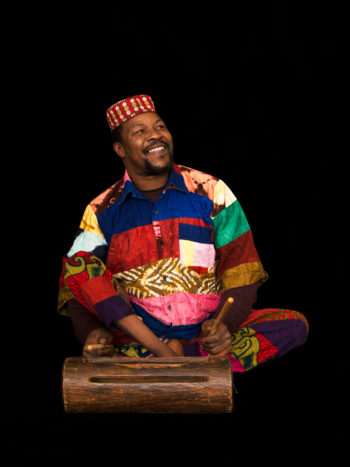
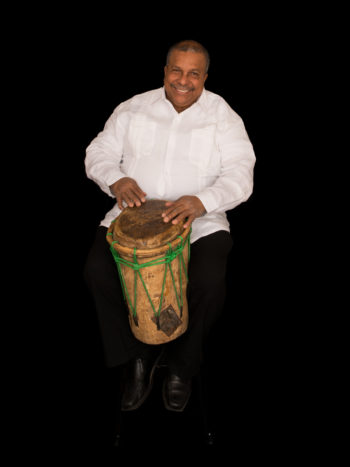
Leonardo Ivan Dominguez; Dominican Republic: folklorist, musician, teacher, founder and director of Conjunto Folklórico de Alianza Dominicana
Object: balsie drum
Estaba tocando bongos con los viejos. El grupo se llamaba Los Soneros de Borojol. Ese era el barrio donde crecí en Santo Domingo, cerca del puerto. (Spanish)
[I used to play bongos with the elders. The group was called The Soneros from Borojol. That was the neighborhood where I grew up in Santo Domingo, close to the port.]
Dovit Davidov; Uzbekistan: musician and instrument maker
Object: tar lute
Искусство требует жертв.
(Russian)
[Art requires sacrifice.]

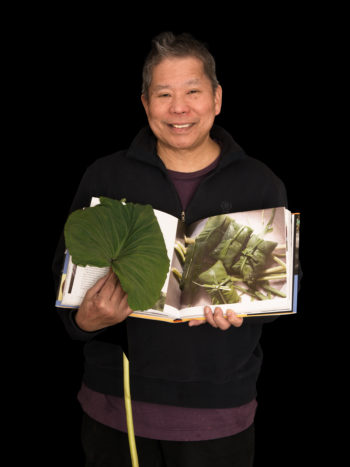
Romy Dorotan; Philippines: master chef and proprietor of the Purple Yam restaurant
Object: taro leaves
Masiramon ang pagkaing Pilipino!
(Tagalog) [Filipino food is delicious!]
Hoang Lieng; Vietnam: cook, proprietor of V-Nam Cafe
Object: sticky rice in banana leaf
Thứ đồ ăn duy nhất tôi có thể mang theo là bánh tét cuốn trong vỏ chuối vì lá chuối sẽ bảo quản đồ ăn trong vòng một tuần. (Vietnamese)
[The only thing I could bring with me when I left on the boat was sticky rice wrapped in a banana leaf, because the banana leaf will preserve it for a week.]


Kewulay Kamara; Sierra Leone: finah poet and storyteller
Object: numu blacksmith’s bellows
Sigi tina koe min ban, tama le woe bana.
(Kuranko)
[What sitting will not solve, travel will resolve.]
Yahaya Kamate; Côte d’Ivoire: dancer, choreographer, teacher
Object: n’goni musical bow
Kabini Karamôhgôh deniou ya karan damnana, gnandunugnanratèguè gnana.
(Mandenka)
[When I went to teach children in schools, it changed my life.]


Samir LanGus; Morocco: Gnawa musician
Object: sintir lute
.إذا ﺣﺎوﻟت اﻹﻧﺳﻼخ ﻋن ﺟذورك، ﯾوﻣﺎً ﻣﺎ ﺳﺗﺑﺣث ﻋﻧﮭم
(Arabic)
If you run away from your roots, one day you will come looking for them -Fatima Tabaamrant, Moroccan Amazighi Singer
Luis Fernando Lechon; Ecuador/Kichwa: artist and musician
Object: family photograph and antique bone flute
Ñukanchik kawsayta, shina sumakta muyumuni, jatirishunchik tucuilla runakunapak tarpunchik allinta purini, chaymanta Mari kawsanguichu.
(Kichwa)
[We live our lives in the way of happiness. We cultivate community together, and we walk in the way of the good. That is our way to live.]
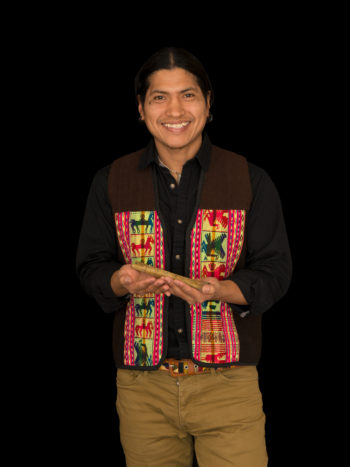
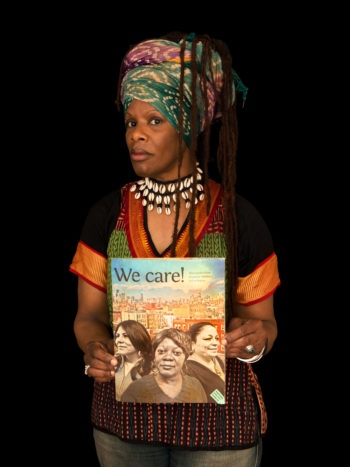
Christine Yvette Lewis; Trinidad: activist, actor, pan player
Object: Domestic Workers’ Bill of Rights
I love the kids I take care of — money can’t begin to pay for that.
Marcus Malchijah; Guyana: milliner, entrepreneur
Object: needle and hat
It was very serendipitous, the way I fell into millinery after my son passed away. I kind of took off running with it, and it always worked in miraculous ways for me. Many times I refl ected that it was a gift given to me by my son.


Rekha Malhotra; India/UK: DJ, producer, educator, creator of Basement Bhangra
Object: Record Gur Nal Ishq Mitha by Bally Sagoo featuring Malkit Singh
Experiencing the sounds on that recording was a life-changing and a career-ignoring moment.
Alma Mićić; Serbia: jazz singer and pianist
Object: Shure SM58 microphone
Џе3 ме је спасио пуно пута.
(Serbian)
[Jazz saved my life many times.]
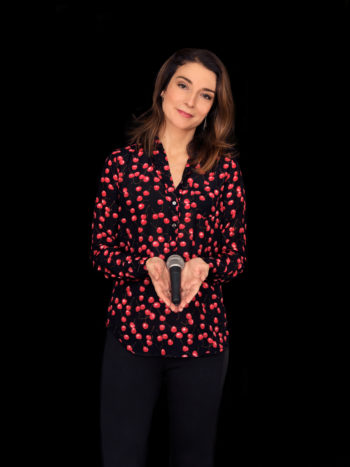
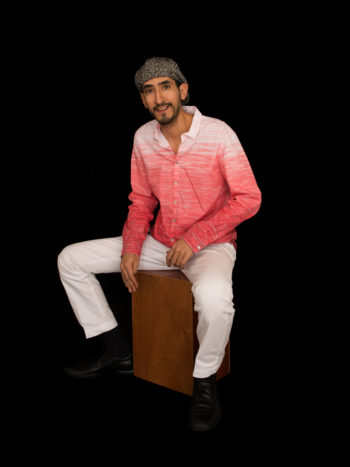
Héctor Morales; Peru: Afro-Peruvian Percussionist and jazz drummer
Object: the cajón
Mi relación con la música afro-peruana y criolla empezó desde el día en que nací. Esta es la músi-ca que mi padre tocaba para nosotros en casa.
(Spanish)
[My relationship with Afro-Peruvian and Creole music started since the day I was born. This was the music my father loved and the music he played for us at home.]
Sahar Muradi; Afghanistan: poet, educator
Object: Divan-e-Hafiz, Hafiz’s collection of poetry and prognostication
ا حافظ شیراز
ترا به شاخ نباتت قسمم میدهم
اگر راست بگویی برایم باره ین سوال...
(Farsi)
[Oh, Hafi z from Shiraz / I promise you to your branch of sugarcane [your sweetheart] / If you tell me the truth about this question…] -Invocation recited before a reading of Hafiz:

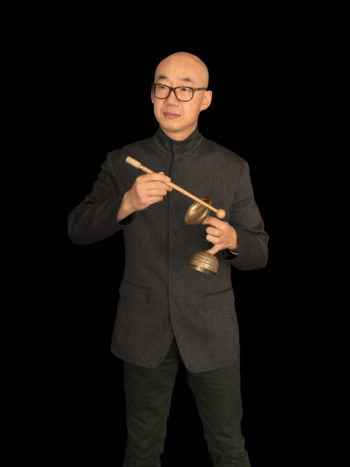
Vong Pak; Korea: drummer, actor, teacher, founder of VP Korean Drum
Object : bronze bells
나는 브레이크 댄서들과 함께 거리공연을 하곤 했다. 난 뉴욕 언더그라운드 아트 씬이 어떻게 돌아가는지 알고 싶었다. 거리 공연 경험이 없었다면 오늘의 내가 존재 할 수 없었다.
(Korean)
[I used to perform with break dancers because I needed to know what was going on in this world. Without the busking, Vong Pak would not exist.]
(Spanish)
Moustafa Rahman; Egypt: mosaic artist, cook restauranteur
Object: The symbols of Alexandria that adorn his restaurant, Mombar
لا أنتظر تقدير الآخرين لأعمالى الفنية، فنى يمتعنى شخصيا و هذا يكفينى
(Arabic)
[My art is what I do to satisfy myself, not to get praise.]


Kesler Pierre; Haiti: visual artist, designer, and percussionist
Object: stained glass lamp
Kenbe fèm pa moli!
(Kreyol)
[Stay strong, don’t get weak!]
Aziz Peerzada; Pakistan: musician, ghazal singer
Object: harmonium
.با ادب با مراد بے ادب بے مراد
(Urdu)
[If you respect everyone, people will respect you; and if you disrespect anyone, people will disrespect you.]
-A saying of Master Inayyat Hussain Shah
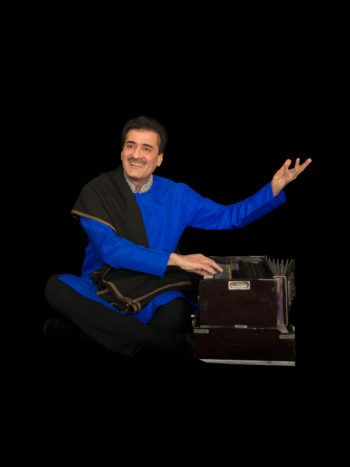

Paula Sanchez; Mexico: Spanish teacher, son jarocho dancer, musician, cultural organizer
Object: calavera Día de Los Muertos skull
Los retos de recrear una tradición cultural en
un contexto distinto al original se convierten en oportunidades de re-pensar dichas tradiciones y adaptarlas a nuevas necesidades. (Spanish)
[The challenges of re-creating a tradition in a new context offers opportunities to re-think these traditions and adapt them to new needs.]
Pritha Singh; Guyana: playwright, director, and co-founder of the Rajkumari Cultural Center
Object: Mala prayer beads
[SAT – CHIT – ANANDA ~ Truth, Consciousness, Bliss]
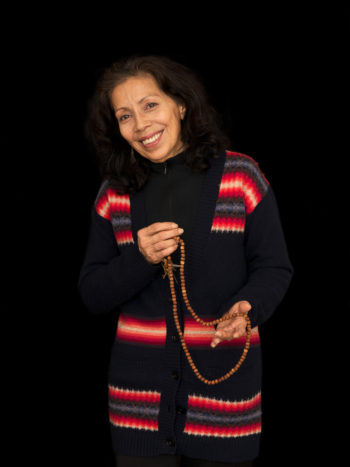
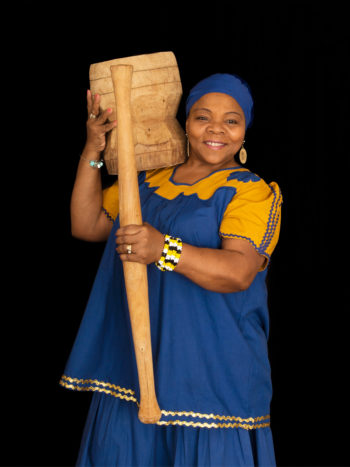
Luz Soliz; Honduras/Gariduna: dancer, choreographer, teacher, activist, and founder of Garifuna Heritage Center for the Arts and Culture
Object: hana and hanaóudua – mortar and pestle
Ágüdahabei bagücha lou babágariduní, bafáreihaní, labu lou barufudahaní sun lácharagun. Buidu me gién lun pantaba lou kátabulá.
(Garifuna)
[Preserve your culture by practicing, sharing, and teaching all the essential aspects of it. Especially, be proud of who you are.]
[Stay strong, don’t get weak!]
Malini Srinivasan; India: classical Bharatanatyam dancer, choreographer
Object: ankle bells
சில நேரங்களில் மிகவும் அழகான பரிசு கூட கடந்த காலத்தில் இருந்து வருத்தம் எண்ணங்கள் வருகிறது; சில நேரங்களில் அது விடுதலையை சாத்தியமாக்குகிறது.
(Tamil)
[Sometimes the most beautiful gift also comes with sad thoughts from the past; and sometimes it brings with it the possibility of liberation.]
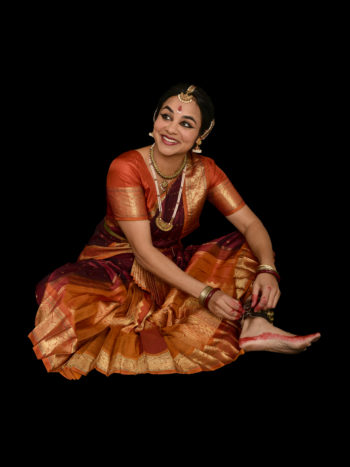
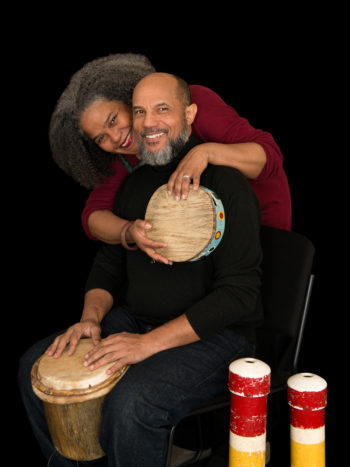
María Terrero; Dominican Republic: singer, cultural organizer, founder of KumbaCarey
Object: pandero frame drum
Para nosotros, los panderos representan legado, resistencia y preservación.
[Spanish]
[For us, the pander drums represent legacy, resistance, and preservation.]
Pedro Raposo; Dominican Republic: dancer, teacher, co-founder of KumbaCarey
Object: futuro trumpet
Los futuros representan resistencia, supervivencia, posibilidades, polirrítmicas y mágica.
[Spanish]
[Futuro trumpets represent resistance, survival, polyrhythmic possibilities and magic.]


Lu Yu; Taiwan: actor, teaching artist, airline steward
Object: Monkey King crown
[America is a country of immigrants, and it’s what makes this country beautiful. That is what I believe.]
Martha Nora Zarate; Mexico: Dancer, choreographer, teacher, founder of Mazarte Dance Company
Object: Jalisco dance dress
Amo a mi México, mi cultura y tradiciones; orgullo-sa estoy de poder compartirlas con la juventud. Sigamos bailando con el corazón. (Spanish)
[I love my Mexico, my culture and traditions; I’m proud to be able to share them with the youth. Let’s continue dancing from the heart.]

Opening at Queens Central Library
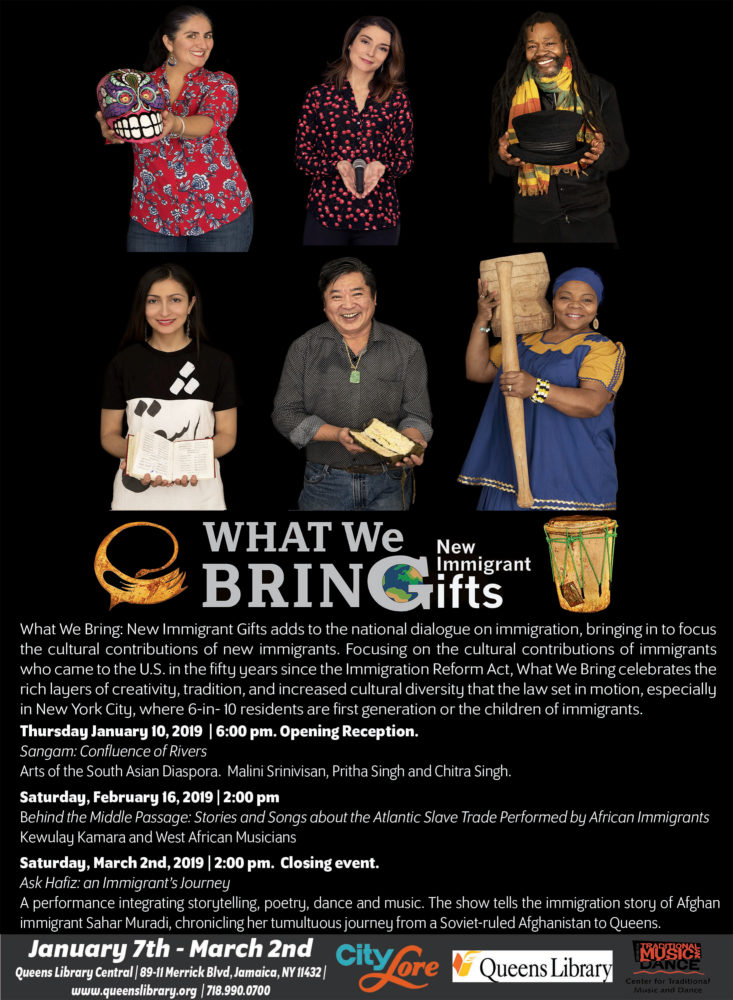
Credits
Credits Photographer: Tom Pich; Curated by: Tom Van Buren & Steve Zeitlin; Research Director: Elena Martínez; Additional photography: Kewulay Kamara; Design: Fred Elman and Ellen Leerburger; Publicity: Carol Klenfner; Graphics and Social Media: Eva Pedriglieri; Lead consultant: Suzy Seriff; Interviews: Marlena Baraf; Interns: Husniya Khujamyorova, Alison Silverstein, and Sarah Singh. Cosponsored by City Lore, Center for Traditional Music and Dance, the Brooklyn Arts Council, and the CATCH consortium. Funded by the Andrew W. Mellon Foundation with additional support from the New York State Council on the Arts and the NYC Department of Cultural Affairs. Special thanks: Ella Baff, Documentary Arts, Alan Govenar, Warren Lehrer, Maurine Loughran, Council Member Rosie Mendez, Chris Mulé, Sahar Muradi, Peter Rushefsky, Holly Sidford, Judith Sloan, Naomi Sturm, and Emily Waters.
